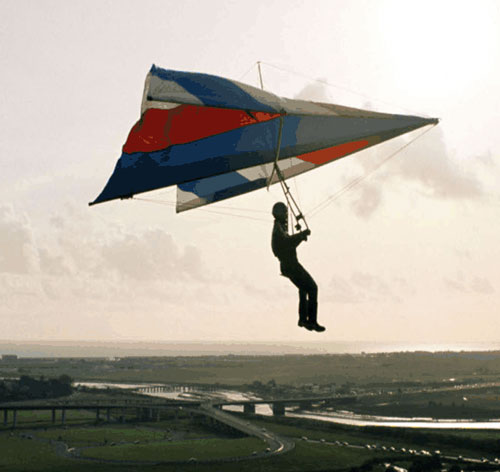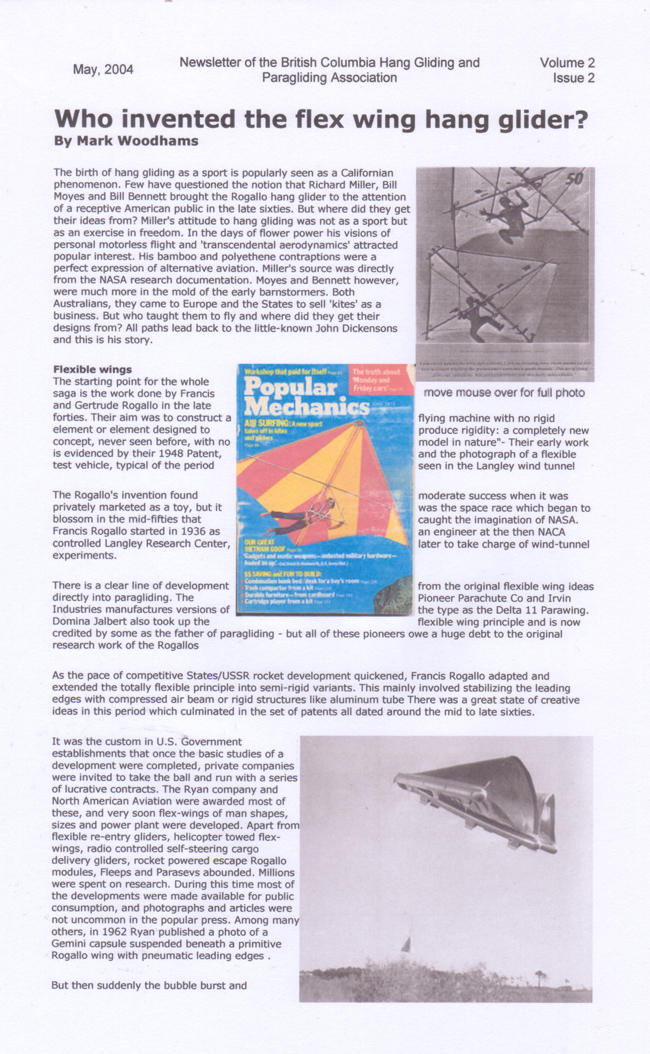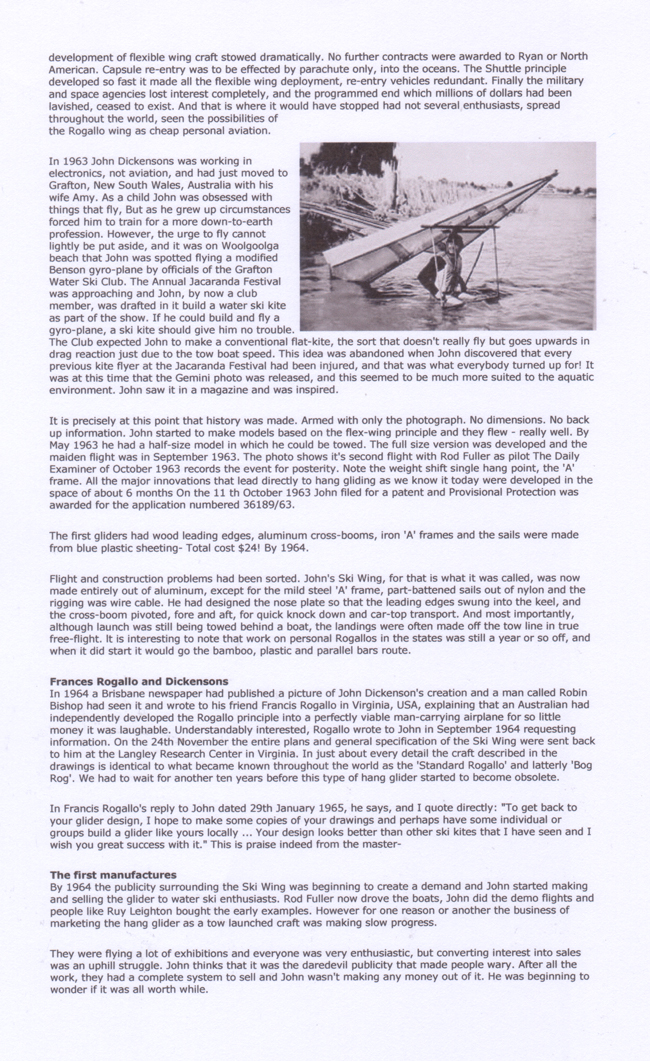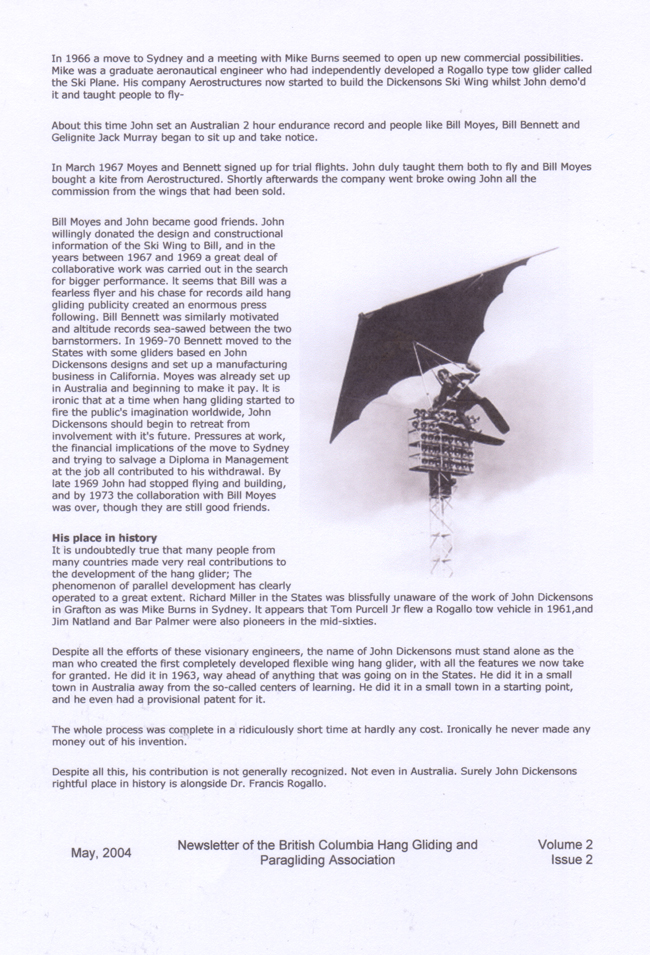 |
Mark Woodhams
Mark is one of our top hang gliding historians. He started in the sport in 1974 and has recorded the very early days from what he experienced while a member of the Southern Hang Gliding Club. However, many of you might not have realised that it was Mark who first brought attention to the possibility that John Dickenson from Australia was the inventor of the swinging hang point, and 'A' frame controled hang glider. What follows are two articles from John, the first his early days, that original appeared in the Southern Hang Gliding Club magazine. While the second is the original article that he wrote about the "Dickenson Wing" and is well worth a read.
Mark was also heavily involved in the building of the UK version of the 'Dickenson Wing' replica, and arranging for John Dickenson to visit the West Country to see it and receive the 'FAI Diploma' on the 27th September 2008.
For photos of this historical event CLICK HERE
Mark Woodhams writes about the early days of Hang Gliding
The beginning
It is amazing how many of the early pilots into hang gliding in the UK were involved with model aircraft. Certainly I was no different. In 1970 I had borrowed a book on aeromodelling from Brighton Library and had been fascinated by a photograph of a flexible wing aircraft called a Rogallo - named after its inventor Francis Rogallo.
I liked its absolute simplicity; just four poles and a bit of slack material slung between three of them. I took up the basic principle of the Rogallo and made many model variants which were to have led to a radio controlled craft which could happily fly hands off and be virtually indestructible. Problem was, I had very little experience of radio control, and proportional gear was very expensive.
Later on I bought the April 1973 issue of 'Pilot' and read the article that was to change my life. There were the Rogallo wings I had been experimenting with, but instead of being radio controlled, they had people hanging off them and controlling them by moving their weight around. As I read on I could feel the hairs on the back of my neck stand up - of course, I would build my own personal aeroplane and I would be the pilot! All around Britain that day there must have been hundreds of like-minded people all setting off on a journey that would lead some to their ultimate dream of personal flight.
I contacted Geoff McBroom who was featured in the article flying an early version of his 'Arion' at Westbury White Horse. I bought plans and flying instructions from him and I also got hold of plans of Dave Kilbourne's 'Kilbokite', which was the first Rogallo to soar for over an hour, at Mission Ridge, San Jose.
However, things were developing faster than my ability to drill holes and put aluminium tube together. Paul Maurice, a friend from College had actually seen people hang gliding at the Long Man of Wilmington in Sussex and reported that one type of glider called a Wasp flew better than the others. We both dashed out to Wilmington, saw Robin and Terry Haynes of Wasp and promptly placed an order for a 229B3 which would be delivered to us two weeks later at a site called Anchor Valley at the back of Brighton. It cost us £175, and split two ways this was a lot cheaper than radio gear.
Mark Woodhams flies Mill Hill in 1974 on a Wasp 229B3
A group of about ten proto hang glider pilots arrived at Anchor Valley on a windswept and wet afternoon and were directed to a pile of what looked like rolled-up brightly coloured tents. These had been unceremoniously dumped onto the hillside from the back of a low loader lorry. We handed over the cash and took the brightest bundle we could find.
Terry Haynes of Wasp asked me if I knew how to fly a hang glider and I foolishly said yes. I had read Geoff McBroom's flying instructions from cover to cover and they seemed very clear, and I was so excited that I didn't want any technicality to get in the way of me strapping myself into the machine and gliding off into the wide blue yonder.
It was very windy at the time so Terry advised us to go down the hill where the wind was less strong. Up to this point I had experienced no fear. My expectation was that as I raised the nose and started to run gently into the wind, the hill would fall away and I would fly to a perfect landing at the bottom. The reality was that I raised the nose, but then shot vertically up thirty or so feet into the air. I pulled the bar in out of sheer panic and shot back down to the ground, landing by a complete chance on my feet. Terry and the others thought that this was very impressive for a first flight, but that we should move
to a more appropriate site, because the wind was too strong and off the slope.
We arrived at Mill Hill, but I was already learning fast. I let the others go first. A wise choice as it turned out. Both the person who flew before me and after me, had crashes which damaged both pilot and 'A' frame. My flight, when it came, was good but I still don't really know what I did right. At any rate I landed safely at the bottom having flown over the tops of several trees, and I remember a shouted 'Geronimo' before folding it all up and racing back to the top of the hill to do it all again.
Feelings like this must be common to all who fly for the first time. I had without knowing become a member of the most exclusive club in the world - free flyers.Formation of the SHGC and the British Hang Gliding Association
The only gliding organisations relevant to us at this time were the NHGA (National Hang Gliding Association) and the BKSA (British Kite Soaring
Association). These two groups were set up supposedly to represent hang gliding at a national level. But what we were beginning to need was a Club that operated at a local level. People were joining the sport at an alarming rate. New pilots would descend on the Downs area with no idea how to behave in the countryside. Gates were left open, crops trampled, permission to fly was not requested. Very soon sites began to be lost and the accident rate began to give us an unsavoury
reputation.
A group of us got together and hurriedly put the Southern Hang Gliding Club (SHGC) together. We started talking to the farmers, the landowners, the local authorities and the Press. Flying Clubs were being started up all over the country and we were all having the same sorts of problem, but there was no effective central body to correlate our efforts.
The NHGA and the BKSA were unable to provide the sort of help that was really needed. The allegiances that were formed at that time were more concerned with the type of hang glider you flew. This factionalism bedevilled the early days of hang gliding. John Malin who operated out of Steyning Bowl was agent for Birdman so those flyers joined the BKSA, but five miles away in Brighton pilots all joined the NHGA because they mainly
flew Wasp and a few flew the emerging Hiway. Yet we were all members of the SHGC. Quite a few of us joined both organisations because we were so hungry for any information related to hang gliding.
Other areas of the country tended to be influenced by whatever make of hang glider was
prevalent in their locality. Len Gabriels in the north with Skyhook, Gerry Breen in the west with CustomKites, and a liberal scattering of Seagull 3 flyers on gliders imported from the States by Critchley Hughes. The two national organisations vied for supremacy and of course the public were utterly confused.Copyright Mark Woodhams
The second article
Who Invented the Flexwing Hang Glider
First published in the British Columbia Hang Gliding and Pargliding Association
May 2004
All the material on this site is subject to copyright Much of this material may only be reproduced with the written permission of the copyright holder |



